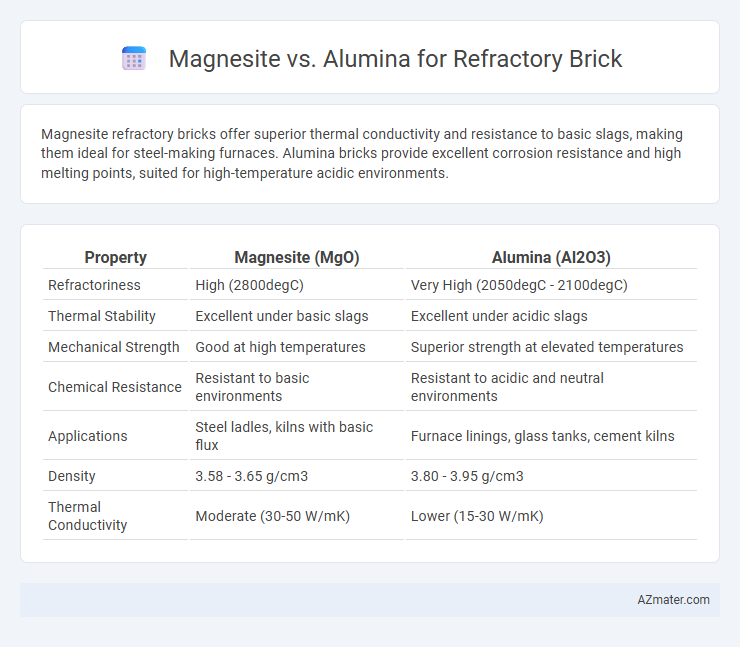Magnesite refractory bricks offer superior thermal conductivity and resistance to basic slags, making them ideal for steel-making furnaces. Alumina bricks provide excellent corrosion resistance and high melting points, suited for high-temperature acidic environments.
Table of Comparison
| Property | Magnesite (MgO) | Alumina (Al2O3) |
|---|---|---|
| Refractoriness | High (2800degC) | Very High (2050degC - 2100degC) |
| Thermal Stability | Excellent under basic slags | Excellent under acidic slags |
| Mechanical Strength | Good at high temperatures | Superior strength at elevated temperatures |
| Chemical Resistance | Resistant to basic environments | Resistant to acidic and neutral environments |
| Applications | Steel ladles, kilns with basic flux | Furnace linings, glass tanks, cement kilns |
| Density | 3.58 - 3.65 g/cm3 | 3.80 - 3.95 g/cm3 |
| Thermal Conductivity | Moderate (30-50 W/mK) | Lower (15-30 W/mK) |
Introduction to Refractory Bricks
Refractory bricks, essential for high-temperature industrial applications, are primarily composed of materials like magnesite and alumina, chosen for their excellent heat resistance and thermal stability. Magnesite bricks offer superior slag resistance and are ideal for basic environments, while alumina bricks provide enhanced mechanical strength and are suited for acidic or neutral conditions. The selection between magnesite and alumina refractories directly impacts furnace efficiency, lifespan, and performance under extreme thermal stress.
Key Properties of Magnesite and Alumina
Magnesite refractory bricks primarily consist of magnesium carbonate and exhibit excellent high-temperature resistance, thermal shock resistance, and basic slag corrosion resistance, making them ideal for steel-making furnaces. Alumina bricks, rich in aluminum oxide (Al2O3), offer superior hardness, chemical stability, and resistance to acidic slags and mechanical wear, suited for environments requiring high abrasion resistance. Both materials provide unique thermal conductivity and refractoriness values, with magnesite showing higher melting points around 2852degC and alumina varying between 1750degC to 2050degC depending on purity levels.
Composition and Manufacturing Processes
Magnesite refractory bricks primarily consist of magnesium oxide (MgO) with a typical purity range of 85-95%, while alumina bricks are made from aluminum oxide (Al2O3) with alumina content varying between 48-90%. Magnesite bricks are manufactured using dead-burned magnesite through processes like pressing and sintering at temperatures above 1800degC, ensuring high-density and chemical stability. Alumina bricks undergo high-temperature firing of bauxite or calcined alumina powders, sometimes incorporating additives to enhance strength and resistance, with manufacturing methods including dry pressing and isostatic pressing.
Thermal Stability Comparison
Magnesite refractory bricks exhibit superior thermal stability with melting points around 2852degC, making them ideal for high-temperature applications such as steelmaking. Alumina bricks, with melting points near 2054degC, offer excellent thermal resistance but are better suited for moderately high temperatures due to slightly lower thermal stability. The higher magnesia content in magnesite bricks enhances resistance to thermal shock and slag corrosion, ensuring longer service life under extreme conditions compared to alumina bricks.
Resistance to Chemical Attack
Magnesite refractories exhibit exceptional resistance to basic slags and alkalis due to their high magnesium oxide content, making them ideal for environments with strong basic chemical attack. Alumina bricks offer superior resistance to acidic slags and environments because of their high alumina content, providing excellent performance against silica-rich slags and acidic chemicals. Choosing between magnesite and alumina refractories depends on the specific chemical environment, with magnesite preferred for basic conditions and alumina for acidic or neutral conditions.
Mechanical Strength and Durability
Magnesite refractory bricks exhibit higher mechanical strength due to their excellent resistance to slag corrosion and thermal shock, making them ideal for high-stress environments such as steel furnaces. Alumina bricks provide superior durability with excellent resistance to abrasion and chemical wear, maintaining structural integrity under prolonged exposure to high temperatures. The choice depends on the specific application, with magnesite favored for mechanical robustness and alumina preferred for long-term durability in aggressive environments.
Application Areas in Industry
Magnesite refractory bricks are predominantly used in steelmaking, cement production, and glass manufacturing due to their high resistance to basic slags and excellent thermal conductivity. Alumina refractory bricks find extensive application in petrochemical plants, incinerators, and metallurgical furnaces where high alumina content provides superior resistance to acidic slags and thermal stability. Selection between magnesite and alumina bricks depends on the specific chemical environment and temperature requirements of the industrial process.
Cost-Effectiveness and Availability
Magnesite refractory bricks generally present a higher cost but offer superior slag resistance and thermal stability, making them economically viable for steel-making industries requiring durability and performance. Alumina bricks tend to be more cost-effective due to their wider availability and lower raw material costs, making them suitable for applications with moderate thermal demands. Availability of alumina is higher worldwide, while magnesite mining is geographically limited, influencing supply chain and cost factors significantly.
Environmental Impact and Sustainability
Magnesite refractory bricks, derived from magnesite ore, offer high thermal stability but involve a more energy-intensive mining and processing chain, leading to greater carbon emissions compared to alumina bricks. Alumina refractory bricks, produced from bauxite, tend to have a lower environmental footprint due to more efficient refining processes and higher recyclability rates. Sustainable practices in both industries focus on minimizing raw material extraction, enhancing brick lifespan, and promoting recycling to reduce landfill waste and resource depletion.
Choosing the Right Material for Your Needs
Magnesite and alumina refractory bricks differ significantly in chemical composition and thermal performance, with magnesite bricks offering excellent resistance to basic slags and high thermal conductivity, making them ideal for steel and cement industries. Alumina bricks, composed primarily of aluminum oxide, provide superior resistance to acidic slags and high temperatures, favored in applications such as glass manufacturing and petrochemical reactors. Selecting the right material depends on the operational environment, including slag chemistry, temperature range, and mechanical stress, ensuring optimal durability and cost-efficiency in refractory lining applications.

Infographic: Magnesite vs Alumina for Refractory brick
 azmater.com
azmater.com